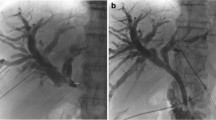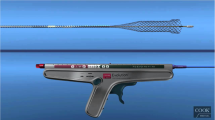Abstract
Purpose
To determine the application and clinical effectiveness of ePTFE/FEP-covered metallic stents for palliation of malignant biliary disease, and to evaluate the efficiency of stent coverage in preventing tumor ingrowth.
Methods
During a 3-year period, 36 patients with malignant obstructive jaundice were treated with ePTFE/FEP-covered stents, with or without proximal side holes. The stricture was located in the lower common bile duct (CBD) in 18 cases, the upper CBD in 9, the lower common hepatic duct (CHD) in 6, and the upper CHD in 3 patients.
Results
Thirty-seven covered stents were percutaneously implanted. The technical success rate was 97%. Reintervention was required in 6 cases. The 30-day mortality rate was 40%, not procedure-related. Mean survival was 128 days. Primary patency rates were 100%, 55.5%, and 25% at 3, 6, and 12 months, respectively, while the assisted patency rate was 100% at 12 months. Stents without side holes had higher primary patency rates compared with those with side holes, where occlusion was always due to tumor ingrowth. Tumor ingrowth did not occur in the completely covered stents. No stent dysfunction due to sludge incrustation was found. Complications were 1 case of arterial laceration that occurred during percutaneous transhepatic cholangiography, and a subcapsular hematoma and 1 case of bile peritonitis, that both occurred during primary stenting. No complications followed the secondary stenting technique.
Conclusion
ePTFE/FEP-covered metallic stents are safe and effective for palliation of malignant biliary disease. The presence of the ePTFE/FEP coating is likely to prevent from tumor ingrowth.





Similar content being viewed by others
References
Adam A (1994) Metallic biliary endoprosthesis. Cardiovasc Intervent Radiol 17:127–132
Brountzos EN, Ptochis N, Panagiotou I, et al. (2006) A survival analysis of patients with malignant biliary strictures treated by percutaneous metallic stenting. Cardiovasc Intervent Radiol [Epub ahead of print]
Gandini R, Fabiano S, Pipitone V, et al. (2005) Management of biliary neoplastic obstruction with two different metallic stents implanted in one session. Cardiovasc Intervent Radiol 28:48–52
Lammer J, Hausegger KA, Fluckiger F, et al. (1996) Common bile duct obstruction due to malignancy: Treatment with plastic versus metal stents. Radiology 201:167–172
Rossi P, Bezzi M, Rossi M, et al. (1994) Metallic stents in malignant biliary obstruction: Results of a multicenter European study of 240 patients. J Vasc Interv Radiol 5:279–285
Thurnher SA, Lammer J, Thurnher MM, et al. (1996) Covered self-expanding transhepatic biliary stents: Clinical pilot study. Cardiovasc Intervent Radiol 19:10–14
Rossi P, Bezzi M, Salvatori FM, et al. (1997) Clinical experience with covered Wallstents for biliary malignancies: 23-month follow-up. Cardiovasc Intervent Radiol 20:441–447
Miyayama S, Matsui O, Terayama T, et al. (1997) Covered Gianturco stents for malignant biliary obstruction: Preliminary clinical evaluation. J Vasc Interv Radiol 8:641–648
Hausegger KA, Thurnher S, Bodendorfer G, et al. (1998) Treatment of malignant biliary obstruction with polyurethane covered Wallstents. AJR Am J Roentgenol 170:403–408
Kanasaki S, Furukawa A, Kane T, et al. (2000) Polyurethane- covered nitinol Strecker stents as primary palliative treatment of malignant biliary obstruction. Cardiovasc Intervent Radiol 23:114–120
Han YM, Jin GY, Lee S, et al. (2003) Flared Polyurethane-covered self expandable nitinol stent for malignant biliary obstruction. J Vasc Interv Radiol 14:1291–1301
Bezzi M, Zolovkins A, Cantisani V, et al. (2002) New ePTFE/FEP-covered stent in the palliative treatment of malignant biliary obstruction. J Vasc Interv Radiol 13:581–589
Schoder M, Rossi P, Uflacker R, et al. (2002) Malignant biliary obstruction: Treatment with ePTFE/FEP-covered endoprostheses-initial technical and clinical experiences in a multicenter trial. Radiology 225:35–42
Carr-Locke DL (2005) Metal stents for distal biliary malignancy: Have we got you covered? Gastrointest Endosc 61:534–536
Tesdal IK, Adamus R, Poeckler C, et al. (1997) Therapy for biliary stenoses and occlusions with use of three different metallic stents: Single-center experience. J Vasc Inter Radiol 8:869–879
Gordon RL, Ring EJ, LaBerge JM, et al. (1992) Malignant biliary obstruction: Treatment with expandable metallic stents—follow-up of 50 consecutive patients. Radiology 182:697–701
Davids PH, Groen AK, Rauws EA, et al. (1992) Randomized trial of self-expanding metal stents versus polyethylene stents for distal malignant biliary obstruction. Lancet 340:1488–1492
Zollikofer CL (1996) Metallic stents in malignant biliary obstruction: Autopsy findings on causes of obstruction. In: Rossi P (ed) Biliary tract radiology. Springer, Berlin Heidelberg New York, pp 387–396
Boguth L, Tatalovics, Antonucci F, et al. (1994) Malignant biliary obstruction: Clinical and histopathological correlation after treatment with self-expanding metal prostheses. Radiology 192:669–674
Kahaleh M, Tokar J, Conaway MR, et al. (2005) Efficacy and complications of covered Wallstents in malignant distal biliary obstruction. Gastrointest Endosc 61:528–533
Isayama H, Komatsu Y, Tsujino T, et al. (2002) Polyurethane-covered metal stent for management of distal malignant biliary obstruction. Gastrointest Endosc 55:366–370
Isayama H, Komatsu Y, Tsujino T, et al. (2004) A prospective randomized study of “covered” versus “uncovered” diamond stents for the management of distal malignant biliary obstruction. Gut 53:729–734
Speer AG, Cotton PB, Rode J, et al. (1988). Biliary stent blockage with bacterial biofilm: A light and electron microscopy study. Ann Intern Med 108:546–553
Kawamoto H, Ishida E, Okamoto Y, et al. (2005) Evaluation of covered metallic stents in malignant biliary stenosis: Prominent effectiveness in gallbladder carcinoma. Hepatogastro-enterology 52:1351–1356
Nakai Y, Isayama H, Komatsu Y, et al. (2005) Efficacy and safety of the covered Wallstent in patients with distal malignant obstruction. Gastrointest Endosc 62:742–748
Kuo MD, LoPresti DC, Gover DD, et al. (2006) Intentional retrieval of Viabil stent-grafts from the biliary system. J Vasc Interv Radiol 17:389–397
Lee BH, Choe DH, Lee JH, et al. (1997) Metallic stents in malignant biliary obstruction: Prospective long-term clinical results. AJR Am J Roentgenol 168:741–745
Nakamura T, Hirai R, Kitagawa M, et al. (2002) Treatment of common bile duct obstruction by pancreatic cancer using various stents: Single-center experience. Cardiovasc Intervent Radiol 25:373–380
Author information
Authors and Affiliations
Corresponding author
Rights and permissions
About this article
Cite this article
Hatzidakis, A., Krokidis, M., Kalbakis, K. et al. ePTFE/FEP-Covered Metallic Stents for Palliation of Malignant Biliary Disease: Can Tumor Ingrowth Be Prevented?. Cardiovasc Intervent Radiol 30, 950–958 (2007). https://doi.org/10.1007/s00270-007-9049-y
Received:
Accepted:
Published:
Issue Date:
DOI: https://doi.org/10.1007/s00270-007-9049-y




